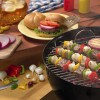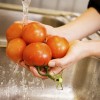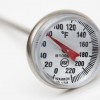 Food is always an important part of holiday festivities, but holiday meals can take a turn for the worse if food safety is not properly practiced when preparing and cooking the food. The food you serve your family and friends can be very harmful if your turkey, ham, or home-prepared meat products are not appropriately handled. The good news is that by practicing four basic food safety measures you can help prevent foodborne illness over the holiday season. This 6-page fact sheet provides information about safe food practices for the holidays. Written by Soohyoun Ahn and Keith R. Schneider, and published by the UF Department of Food Science and Human Nutrition, December 2014. (Photo: Stockbyte/Thinkstock)
Food is always an important part of holiday festivities, but holiday meals can take a turn for the worse if food safety is not properly practiced when preparing and cooking the food. The food you serve your family and friends can be very harmful if your turkey, ham, or home-prepared meat products are not appropriately handled. The good news is that by practicing four basic food safety measures you can help prevent foodborne illness over the holiday season. This 6-page fact sheet provides information about safe food practices for the holidays. Written by Soohyoun Ahn and Keith R. Schneider, and published by the UF Department of Food Science and Human Nutrition, December 2014. (Photo: Stockbyte/Thinkstock)
http://edis.ifas.ufl.edu/fs260
Tag: Food Safety in the Home
Food Safety at Tailgating
 While tailgating can be a great fun for family and friends, you need to make plans and take on-site precautions to keep your food safe during these events. Since refrigerators and running water are not always available for the events, you should familiarize yourself with the safe food handling practices for these outdoor events and plan ahead so you will be prepared with enough coolers/ice and all the tools you need to keep and cook your food safely. This 3-page fact sheet provides information on safe food practices for tailgating and other outdoor sporting events. Written by Soohyoun Ahn, Amarat H. Simonne, and Keith R. Schneider, and published by the UF Department of Food Science and Human Nutrition, October 2014.
While tailgating can be a great fun for family and friends, you need to make plans and take on-site precautions to keep your food safe during these events. Since refrigerators and running water are not always available for the events, you should familiarize yourself with the safe food handling practices for these outdoor events and plan ahead so you will be prepared with enough coolers/ice and all the tools you need to keep and cook your food safely. This 3-page fact sheet provides information on safe food practices for tailgating and other outdoor sporting events. Written by Soohyoun Ahn, Amarat H. Simonne, and Keith R. Schneider, and published by the UF Department of Food Science and Human Nutrition, October 2014.
http://edis.ifas.ufl.edu/fs256
Safe Dishwashing Without an Automatic Dishwasher for Home, Community Events, and Outdoor Activities
 Most of us are accustomed to the ease and convenience of washing our dishes in an automatic dishwasher. At times, however, no dishwasher is available. This 4-page fact sheet teaches ways to safely wash or clean your dishes by hand, which may be necessary when your dishwasher is broken, you are outdoors, or you are working in a facility without a dishwasher. Written by Morgan Denhard, Amy Simonne, and Ricki McWilliams, and published by the UF Department of Family Youth and Community Sciences, December 2014.
Most of us are accustomed to the ease and convenience of washing our dishes in an automatic dishwasher. At times, however, no dishwasher is available. This 4-page fact sheet teaches ways to safely wash or clean your dishes by hand, which may be necessary when your dishwasher is broken, you are outdoors, or you are working in a facility without a dishwasher. Written by Morgan Denhard, Amy Simonne, and Ricki McWilliams, and published by the UF Department of Family Youth and Community Sciences, December 2014.
http://edis.ifas.ufl.edu/fy1403
Home Gardening Food Safety: Washing the Fruits (and Vegetables) of Your Labor Properly
 Having a home garden has become popular recently. It is a great way to enjoy fresh fruits and vegetables—foods that are an important part of a healthy diet. However, just because you have your own garden and control how it is treated does not make the fruits and vegetables you grow safer than those you buy in the store. To reduce the chance of getting sick from foodborne illnesses, you must wash the fruits and vegetables you grow before eating them raw or cooked. This publication helps you learn the proper way to clean your fruits and vegetables so you can enjoy them safely. This 4-page fact sheet was written by Eshani Persaud, Amy Simonne, and Karla P. Shelnutt, and published by the UF Department of Family Youth and Community Sciences, November 2013.
Having a home garden has become popular recently. It is a great way to enjoy fresh fruits and vegetables—foods that are an important part of a healthy diet. However, just because you have your own garden and control how it is treated does not make the fruits and vegetables you grow safer than those you buy in the store. To reduce the chance of getting sick from foodborne illnesses, you must wash the fruits and vegetables you grow before eating them raw or cooked. This publication helps you learn the proper way to clean your fruits and vegetables so you can enjoy them safely. This 4-page fact sheet was written by Eshani Persaud, Amy Simonne, and Karla P. Shelnutt, and published by the UF Department of Family Youth and Community Sciences, November 2013.
http://edis.ifas.ufl.edu/fy1401
Food Safety within the Household (FSHN12-10/FS195)
 Although food safety education is well established, people still become infected with foodborne illnesses by practicing unsafe behaviors in their kitchen. People who know the basics of home food safety may not always put theory into practice. Consumers must learn more about how food becomes unsafe to eat and modify their current beliefs and behaviors. This 5-page fact sheet was written by Lucianna Grasso, George L. Baker, Renée M. Goodrich-Schneider, and Keith R. Schneider, and published by the UF Department of Food Science and Human Nutrition, October 2012.
Although food safety education is well established, people still become infected with foodborne illnesses by practicing unsafe behaviors in their kitchen. People who know the basics of home food safety may not always put theory into practice. Consumers must learn more about how food becomes unsafe to eat and modify their current beliefs and behaviors. This 5-page fact sheet was written by Lucianna Grasso, George L. Baker, Renée M. Goodrich-Schneider, and Keith R. Schneider, and published by the UF Department of Food Science and Human Nutrition, October 2012.
http://edis.ifas.ufl.edu/fs195
Keeping Food Safe: Choosing and Using Food Thermometers in Homes (FCS1083/HE770)
 Proper cooking of foods to safe internal temperatures is one of the most effective ways to prevent foodborne illnesses. Several types of food thermometers are available for purchase, and choosing the right one when cooking at home will help to keep food safe for your family. This 3-page fact sheet provides specific information on how to use different thermometers in different foods. Written by Claudia L. Peñuela, Amy Simonne, and Isabel Valentin-Oquendo, and published by the UF Department of Family Youth and Community Sciences, March 2012. http://edis.ifas.ufl.edu/he770
Proper cooking of foods to safe internal temperatures is one of the most effective ways to prevent foodborne illnesses. Several types of food thermometers are available for purchase, and choosing the right one when cooking at home will help to keep food safe for your family. This 3-page fact sheet provides specific information on how to use different thermometers in different foods. Written by Claudia L. Peñuela, Amy Simonne, and Isabel Valentin-Oquendo, and published by the UF Department of Family Youth and Community Sciences, March 2012. http://edis.ifas.ufl.edu/he770